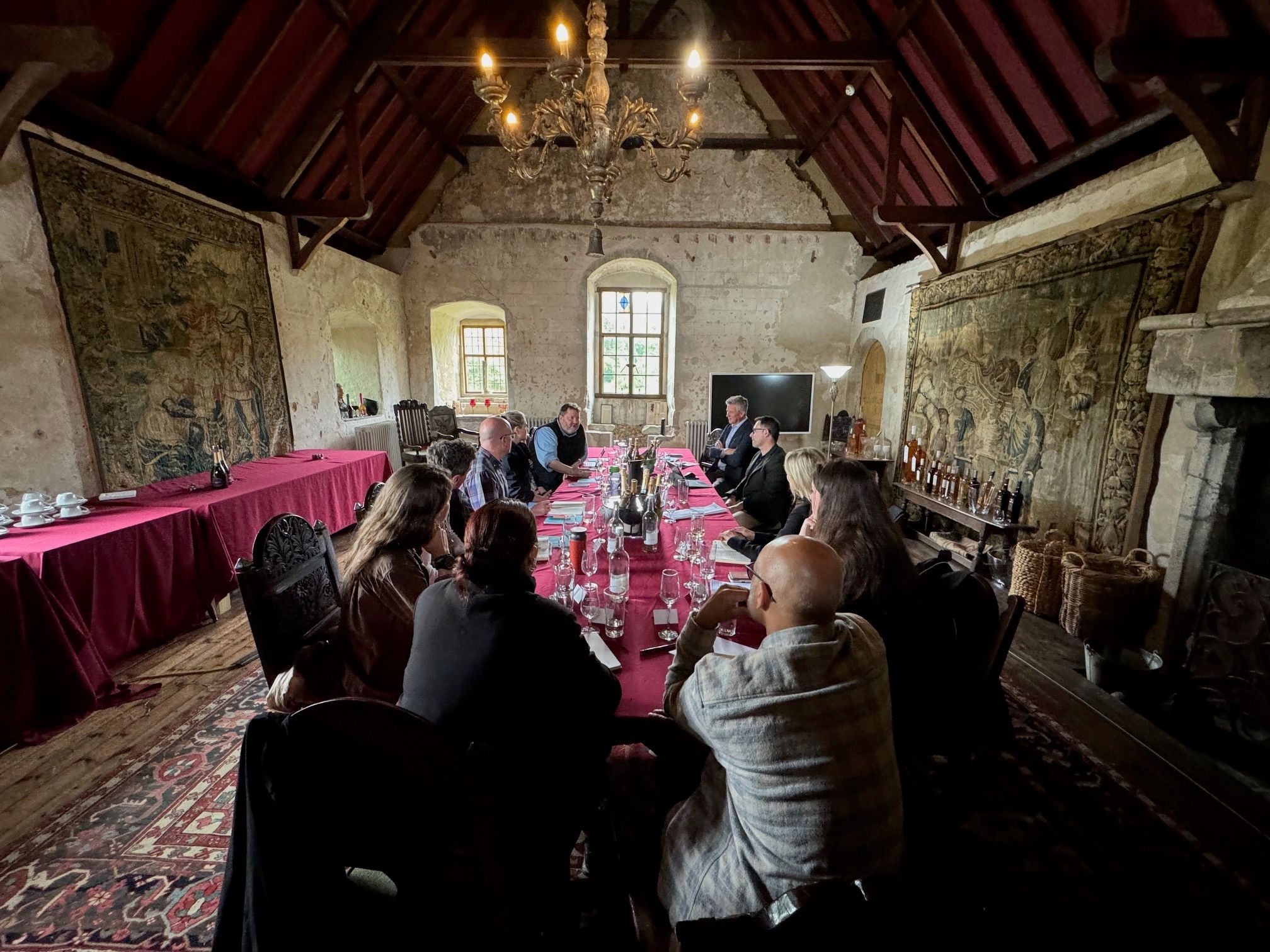For a debate focused on looking at the future of the English wine industry, the setting could not have been more startling. Or historic. MDCV UK might publicly want to be known as the “most disruptive” wine producer in the UK, with a multi-million-pound investment and commitment to create and grow a new Charmat wine category, but its home is as traditional as they come. And then some.
For when billionaire Mark Dixon, owner of Regus, the flexible workplace company, wanted to find a home for his new wine business in 2019 he settled on Luddesdown, a small hamlet that includes Luddesdown Court , once owned by William the Conqueror’s half-brother, Odo, and is said to be the “the oldest continually occupied house in the country”.

The historic Luddesdown Court at Silverhand Estate was the setting for The Buyer and MDCV UK English wine debate
It has now become the central hub for MDVCV UK’s hugely ambitious and highly impressive new English wine business centred around enhancing theland it owns in the neighbouring area to create what can now claim, at close to 600 acres, to be the UK’s single largest organic vineyard, Silverhand Estate, with major plans to plant and grow furthervines in the area.
It also owns four other vineyards in different areas of southern England - Sedlescombe (East Sussex), Kingscote Estate (West Sussex), and two ancillary vineyards located in Essex and East Sussex - giving it access to fruit from a wide range of terroirs, whilst also providing vintage protection in bad harvest years.
It also owns over 1,000 acres of land and vines in Provence, including its flagship Château de Berne, which, together with its English operation makes them in 2024, in their own words, “one of the largest producers of wine in each of these regions, with a combined production of over 10 million bottles annually”- of which over 5m bottles is on course to come from the UK in 2028.
Need to change
The “disruptive” tag is often thrown around in product and category areas where it is possible to rip up the rule books and do something radically different. But not, up to now, in such a traditional sector as English wine. Even if so much of the sparkling wine it makes is done so in the traditional method.

The scale of MDCV UK's Silverhand Estate has to be seen to be believed...
In that context alone MDVCV UK and Silverhand Estate were certainly the right partners to co-host a debate on the future of English wine. After all its very existence and business model relies on disrupting and changing the future of English wine by stealing market share from traditional old world regions, such as Cremant, Prosecco and Cava. .
As its chief executive, Gary Smith, said: “We are coming in to disrupt the English wine category. We want everyone to be able to drink English wine from entry level upwards, and encourage consumers to drink more local and sustainable products.”
To help explore, analyse and assess just what the future of English wine could be was a cross section of buying, trading and branding talent in the UK wine industry including:
- Dror Nativ MW, senior wine buyer, Marks & Spencer.
- Rebecca Palmer, associate director and buyer at Corney & Barrow.
- Henry Connell, co-founder, The Uncommon.
- Phoebe French, communications manager at WineGB.
- Giles James, wine buyer for the Groucho Club.
- Joe Wadsack, wine consultant and broadcaster.
- Zoé Danadio, restaurant manager and head sommelier at Apricity.
- Florence Papougnot, head of PR & partnerships, at The Uncommon.
- Emma Clark, marketing director, MDCV UK.
- Gary Smith, chief executive MDCV UK.
Dror Nativ was able to start the debate by setting out just how seriously one of the UK’s most respected and influential major retailers is taking English wine. “We see English wine as a hero category and one we want to nurture and over invest in. As a result we have doubled our English wine category in the last three years.” he explained.
English wine has had such an impact at Marks & Spencer that English sparkling wine is now its third biggest selling wine category after Prosecco and Champagne and sells more than Cava. The chain now has an English range that covers 12 sparkling wines and six still wines with a year-on-year increase in sales of 35% in sparkling wine sales and 23% in still. M&S has also introduced English sparkling wine into its premium Collection range that features the best wines from famous wine regions and countries around the world.

Bramble Hill is an exclusive Marks & Spencer sparkling wine of England produced in partnership with MDCV UK
Nativ said M&S now sees English wine as a “pioneering” wine category which is why it was keen to be first to market with tank method Charmat - Bramble Hill in a breakthrough partnership with MDCV UK - and last month was the first UK supermarket to introduce an English pet nat sparkling to its range.
“It has gone down really well and we sold twice as much as we expected in the first two weeks,” he added. “We wanted to have a consumer friendly style of pet nat. A rosé pet nat style and packaging, in a crown cap, that was bright, colourful and had a visual impact - £15 is also a really good price. There is a thirst for something that is creative and less traditional. It’s really exciting,”
Smith hopes it can become a “sign post” for English wine at a different price level.
English wine is also a “hero” country that Giles James wants to push at the Groucho Club, particularly now it has Mark Hix on board as head of food and beverage, and it has an even bigger focus on sourcing locally.
Its wine list now opens with a page of all the English wine producers James has brought to the club in the last couple of years.
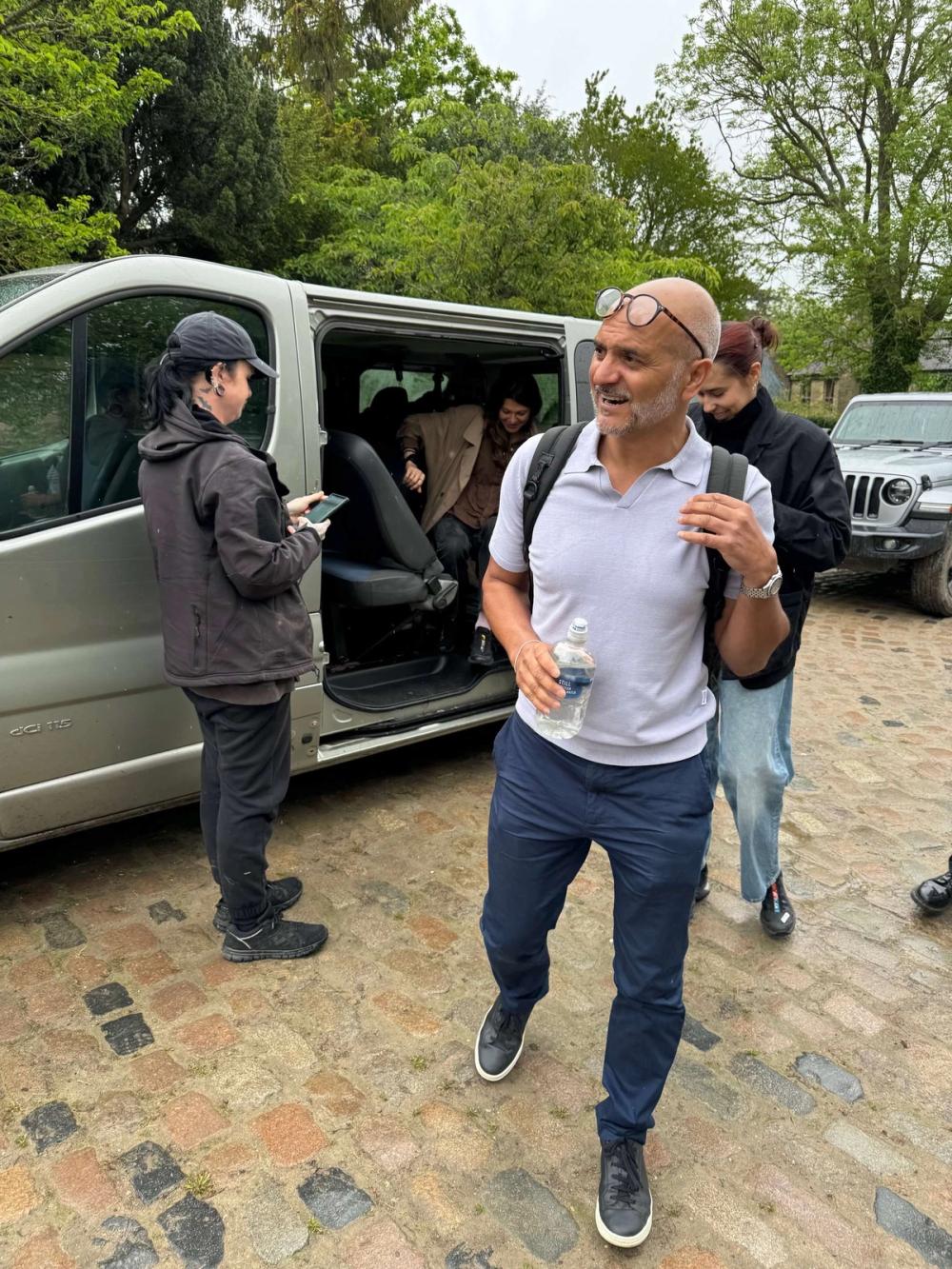
Groucho Club's Giles James arriving at Silverhand Estate
He says he first really started to champion English wine during his days buying wine for Noble Inns in the mid 2010s and was in the position of putting tenders out for English sparkling wine.He is excited to see how far what was then a “burgeoning” sector has come, not only in size but in quality and diversity and the sheer choice that is now open to restaurant wine buyers like himself.
“I have been able to introduce a lot of English wine over the years and it is now such an exciting category,” he added. “We really want to celebrate small producers at Groucho. It’s a great project to work on.”
He also started an initiative during lockdown called the English Collection, based on his previous experience working for New Zealand wineries in the UK, by doing the opposite and trying to place and find distribution for English producers in growing markets around the world like Japan and China. “It worked really well at the time and it would be good to revisit that again at some stage.”
Rebecca Palmer said Corney & Barrow has also had a long relationship with a number of English wine producers, both through its merchants and fine wine business, but also during the time when it ran its own chain of wine bars. She recognises the role that major distributors like Corney & Barrow can play in giving the support, guidance and, most of all, distribution to smaller producers who may not have the teams and expertise in building sales.
English wine clearly ticks all the boxes at a closed loop, local, regenerative farming sustainable, sourcing restaurant concept such as Apricity, said Zoé Danadio. She sees its role as “challenging people’s perceptions about English wine” and is looking to “discover new producers that work well with organics and people who are looking to treat their vines well”.
Which means making the extra effort to source your own producers, particularly for a list that changes so much season to season, as well as take some from your suppliers, she added.
Challenging perceptions
The panel of buyers arriving at Ludesdown Court for the debate
“Challenging people’s perceptions about English wine” is also a mantra that has become a business strategy for The Uncommon that was co-founded in 2017 by Henry Connell as an exclusively English wine in a can business. Quite a radical business idea now, never mind seven years ago.
Connell said he has seen the success that canned wine was having in the US and thought it was the ideal time for a new canned brand focused on championing what English wine can do best - in a can. It has gone from sourcing around five tonnes of Bacchus a year in 2017 to over 400 tonnes now. But it has not been easy. Far from it.
In fact it’s fair to say newcomers and disruptors to the sector, like The Uncommon, have not always been welcomed with open arms by the more traditional side of the English wine industry.
MDCV UK can also testify to that. After all, simply mentioning the word Charmat at an English wine event a few years ago would havebrought many out in a horrible rash. Now MDCV UK is intent on making Charmat the go-to wine category for anyone who wants to buy English sparkling wine for less than £20. A business model that is focused on competing head on with Prosecco and looking to take market share away from sparkling wine, in all its forms, at around £15 a bottle.
“We are at a tipping point,” he said. “The amount of people selling traditional English sparkling wine is plateauing. English wine can start taking share from Prosecco with Charmat. There is also a bigger role for our still wines to have as well.”
Which is why its breakthrough Charmat deal with M&S was so important, with potentially other major retailers ready to follow. Which will be essential if it is to sell its target 5m bottles of production, up to 70% of which will be Charmat.
Nativ said the reason M&S was so keen to introduce a Charmat style was to open up English wine to more customers. The lack of awareness about English wine was the sector’s “biggest Achilles heel” was also potentially a big “opportunity,” he added.
English sparkling wine, he stressed, was only currently around 2% of the market and “we need to get more people into the market and see more listings in the on-trade”. He welcomed any moves that gave “more support to the industry” and “diversity” for its customers - like Charmat as an alternative to Prosecco.
“We need more product in front of customers on shelf and on restaurant lists telling their story,” he added. “It is exciting to new formats and packaging ideas.”
Removing barriers
The Uncommon's Henry Connell believes English wine has the capacity to be the most exciting wine country in the world if it can rid itself of its some of its inhibitions and open up to new ways of making wine be it in a can or Charmat style
Connell is quite clear where the industry now stands: “English wine could be the most exciting country in the world if we get out of our own way,” he claimed.
By that he means removing barriers to entry and welcoming, embracing and supporting newcomers that are looking to do what they can to grow the English wine category rather than not giving them the time of day.
“There is still a lot of work to be done in that area,” he added. “In my experience people not doing traditional method sparkling wine are not supported by the English WineGB community.”
But if it can find ways to open up and be more radical then there are enormous opportunities to be had. Just look at how all the major airlines are now turning to canned wine for their wine offer, he said.
Wadsack agreed: “Charmat also tastes and performs better at altitude too. It is perfect for airlines.”
“There is too much focus on traditional method in the UK when so many people want to drink Prosecco or New Zealand Sauvignon Blanc,” added Wadsack. “The market is there if we can convert people over from Prosecco to Charmat. We are also a country that is spoilt for choice and we are used to having choice in what wines we can drink.”
Smith could not agree more: “It is so exciting to be part of the English wine trade at this exact time and we are even more excited to see what we can do.”
Connell said it all comes down to “choice”. “We don’t need to create new wine drinkers, we just need to convert existing wine drinkers to similar styles grown domestically. The UK is the largest consumer of Prosecco and the second largest consumer of Champagne (after the US) in the world. We have everything we need on our doorstep. The market size is currently small because we’re focusing on traditional method which tends to be limited to celebratory occasions and the top 1%. If we broaden this range, we can unlock more of the market.”
Time is also off the essence, he stressed: “We could see our third consecutive large harvest. We’re in danger of having an oversupply which would have knock on effects on pricing.”
Palmer welcomed the new level of “disruption” we are now seeing in the sector, but also argued the English wine community is not necessarily “resistant to change” it’s just the traditional method of making sparkling wine was where the industry started and has come from. It simply was not possible to make Charmat before as the economies of scale did not add up, she added. Which is why we see so many plantings of traditional Champagne varieties in the UK.
Innovation not imitation
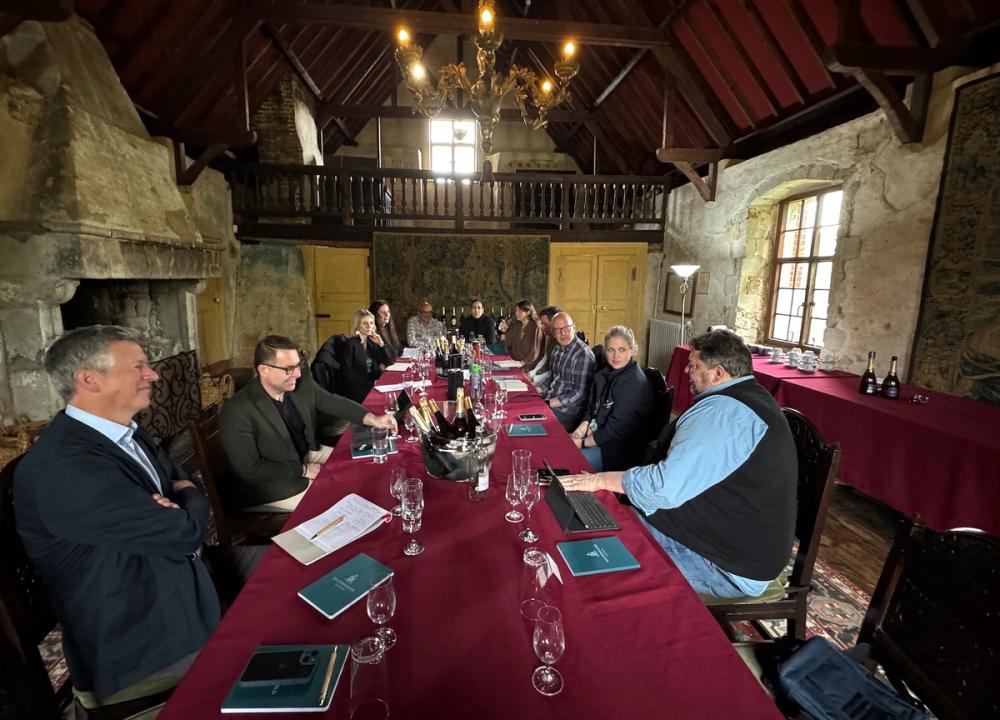
The stunning historic setting in order to discuss the future of English wine
Connell, though, stressed “you are limiting the size of the market” if you only focus on traditional method and end up selling wines at £25 to £30 plus to what is effectively only 1% of the market.
“People should be supported to plant and try new clones and be open to new ideas and experiment, people who are not just doing traditional method sparkling wine. There is room for everyone and we should not be downgrading those who make Charmat . We also have to remember that the English wine market is still tiny,” he added.
Chris Mitchell, owner of Cube Communications that provides PR services to MDCV UK, put it nicely when he said: “We need to stop being imitators and start being innovators. Does it not need to be more Brewdog in its approach? To start pushing the rules of what is possible in both traditional and other styles of English wine.”
Connell agreed and feared the English wine industry had already put itself on the back foot by focusing so much on essentially copying Champagne with the premium traditional method sparkling wines being produced and the Champagne varieties that have been so widely planted.
Smith said the English wine industry was not equipped to take on the big Champagne houses and brands as it did not have the “brand heritage” or “marketing dollars” to compete fully in that space.
Palmer felt it was more a case of an industry that has “taken time” to mature and grow and was now ready to explore other opportunities.
Emma Clark, marketing director at MDCV UK, said it is now vital the English wine industry listens to and understands “what the consumer wants” if it is to reach and maximise its potential. The average shopper, she added, is looking for sparkling wines that can sit on shelf at around £12 to £15 - the phenomenal success of Prosecco, and lesser degree Cava is testimony to that. They are also looking for premium traditional method sparkling wines too.
“It is catering for different consumers,” she stressed. “As an industry we should be coming together and supporting each other. Every voice is important in the sector. But some are reluctant to do that.”
“We have the chance to build some amazing brands in English wine. That is what we are passionate about. The opportunity to create brands that are accessible for everybody. We just want to be given the chance to give it a go,” she said. “We are targeting the Prosecco consumer. That is where the charmat market is. We are not looking to take market share away from traditional English sparkling wine. It is hard at the moment for those who are making non traditional method sparkling wine.”

Joe Wadsack with MDCV UK's Emma Clark
Interestingly Wadsack said the English wine model has “been designed by the producer and not the market” particularly when it comes to which grape varieties have traditionally been planted in the UK.“We are seeing a paradigm shift in climate change which now means it is possible to plant a whole different range of varieties like Riesling.”
The scale of growth at MDCV UK shows what can be achieved with a different approach. Smith described it as a “rollercoaster five years” that has seen it go from zero production in 2019, to 200,000bottles in 2022, 500,000 in 2024 and on course to hit 1 million bottlesin 2025.
“We want Silverhand Estate to be the home of English wine,” said Smith and is awaiting planning permission to build a new winery and tourism centre designed by Lord Norman Foster on its Silverhand Estate.
Balancing act
Much of the focus on how far, and how quickly the industry can change rests with Wine GB and the influence and role it has to play. It is in a difficult position in finding a way forward that can please such a diverse membership base that covers 90% of English wine production, where two thirds of its 450 grower members own less than three hectares of land, in a market where the top 25 producers account for 83% of sales.
It’s a delicate balancing act that Phoebe French, communications manager, recognises it will need to continue to address and “be much more inclusive” and able to “support everyone and all styles” in the coming months and years. Which is why it is putting a bigger focus on strengthening it regional bodies and introducing initiatives like its Rising Star awards so that it opens itself to a younger generation and strengthens its education and lobbying activity.
“There is room for everyone and having different categories makes our industry stronger,” she said. “People are coming together and talking more.”
It’s also an opportunity for new faces and backgrounds to help re-shape conversations and agendas, which is very much where Nicola Bates, WineGB’s new chief executive, is hopefully able to make a difference - particularly with her front line political lobbying experience at the Portman Group and as a former parliamentary candidate really come to the fore.

There was a consensus amongst the panel that exciting times lie ahead for English wine - it also needs to find ways to build consumer demand
Changes are being made. Gary Smith, for example, has been invited to head up a new WineGB sales and marketing working group and look at new ways to help the industry as a whole fast track its whole sales, commercial and marketing strategy and for WineGB to “be a force” within that. An opportunity to create a “category blueprint” for the industry that “helps promote different modes of production,” he said.
“We are particularly pleased to be now working with WineGB and doing what we can to help build up marketing and sales across the industry. It’s great to see the energy and drive around what they are doing now. It is a massively layered approach,” he added.
A strategy focused on driving more sales of English wine through: better awareness; more visibility; and better distribution.
A need also to lobby and work with the next government to ensure the industry gets the administrative protection it needs - particularly around the treatment of bulk wine being brought into the UK - and the need for more cellar door and producer relief.
“We are at such an exciting point for our industry and we don’t want to be suffocated before it can grow,” said Emma Clark.
Opportunity for still wines

The new tasting room at Silverhand Estate gives guests the chance to taste its full range of sparkling and still wines
A future for English wine that is also very much about the quality of the still wine being produced as it is its sparkling. If production levels are going to be 23m bottles and more in the coming years it needs to have other routes to market that opens up the sector to more consumers.
The current proportion for still wine production is around 35-40%, said Smith, but it has a very low awareness with the consumer compared to sparkling. But that is all set to change.
“The scale and opportunity is there, particularly the purchase price barrier for English wine and what still wines can offer,” he added.
Nativ agreed: “There is more elasticity in pricing in still wines than there is with sparkling wine.”
“The opportunity for still wine is huge,” said Connell as it simply opens up English wine “to more people” as “more people drink still than sparkling”. Simple as that.
He said he could see The Uncommon soon “selling more still than sparkling wine” and as a business it opens up so many more opportunities for listings, particularly in the on-trade at events, festivals, and sporting venues. “There are more sponsorship opportunities for still than there are in sparkling as well.”
It has been looking to find the best sources for still wines and planting more still grape varieties at its own 15 hectare vineyard. “We are now making great quality still wine and know how to do it.”
Papougnot said England now had so much more fruit capable of making lighter style quality wines - particularly Pinot Noir - “that people are looking for”.
James agreed: “A lot of the future innovation will come in still as well as sparkling wine. Particularly in terms of packaging. Look at what Gutter & Stars is doing with its still bottles. It is having such fun with its labels.”
“The trade can also do more,” he added, who was keen to “do more with English wine in keg” and how that could help open up so many doors in the on-trade with more restaurants and bars.
English still wines are also well placed to make lighter and lower in alcohol still wines too, said James. “I also like the idea of blends and would like to see more white blends - I am looking for those. An Ortega, Chardonnay and Bacchus blend for example. It’s also a great way to support smaller producers.”
Wadsack said the English climate made a lot of sense for blended wines and multi vintage blending.
It is also a chance to bring younger consumers into the sector, added Palmer, who sees a big opportunity for still Bacchus wines. Nativ agreed: “I think Bacchus has got a lot of potential.”
“There is already some brilliant Bacchus out there,” said Wadsack who believed it could become the country’s signature grape variety - like Pinotage in South Africa.
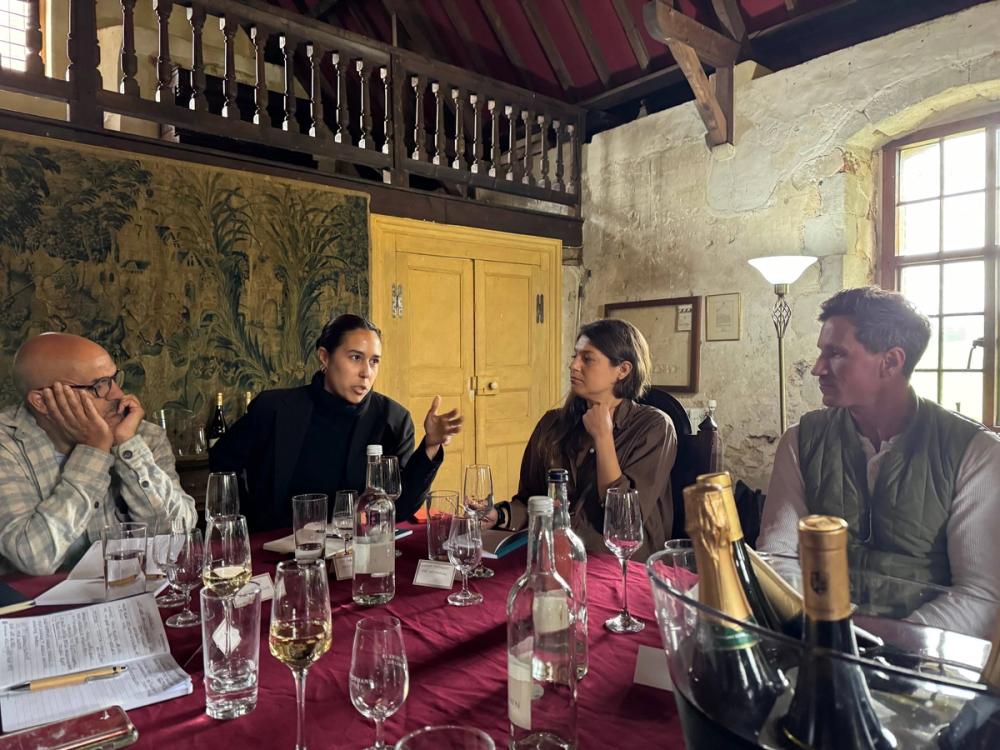
Zoe Donadio at Apricity said there was demand out there for brave, ambitious still English wines
Donadio said she would love to see more different styles of English wine that sit outside a supermarket aisle. “Most of the wines we list are still wines. We want to see more of them with funky labels. Wines that stand out and give our customers more choice,” she said.
Apricity is regularly selling still bottles of English wine for around £70 to £80 on the list. “We want people to try them and when they do there is just so much to say about them. People don’t tend to go over £100 for English wine,” she added.
Having more still wines will also help get more people talking about English wine, said Wadsack. “I can’t educate people about wine if they are not asking questions in the first place.”
James said he does a lot of work at Gaucho training the team with English wine and giving them the insights and stories to work with.
Donadio agreed training was “key” in getting restaurant teams on board with English wine.
Sustainable edge
A crucial way forward for English wine that could really help cement its position in the overall UKwine sector is the widespread commitment to farm sustainably and follow organic, and regenerative farming practices that are increasingly going to be in tune with what the public want to invest in and what the major retailers want to source.
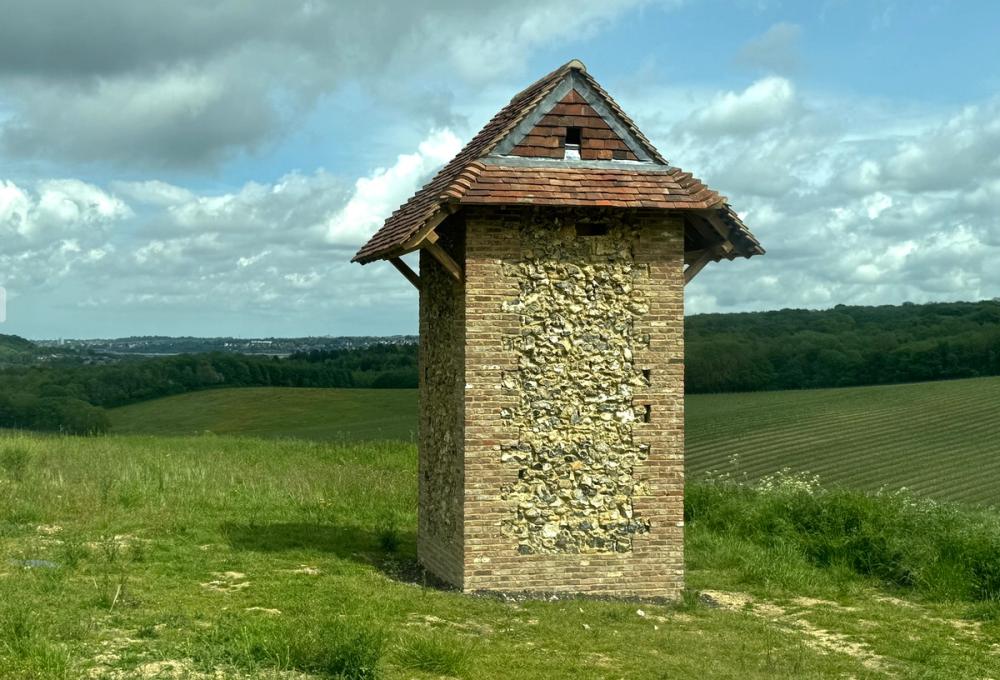
One of the sustainability measures at MDCV UK is to build towers to attract and allow birds, owls and bats to build nests there
MDCV UK, for example, are following and implementing a wide range of environmental measures at its estates, particularly at Silverhand where it is following organic and regenerative farming principles across the further 600 acres not being used for vines, that also includes introducing livestock sheep, bees and six wildlife towers to act as homes for bats, owls and birds of prey and help the overall biodiversity of the area.
Zoe Apricity said the sustainable approach is what will excite restaurant buyers and sommeliers. It is what will make so many more estates attractive as it also gives them a story to tell to their customers.
Palmer said there is also a need for the trade as a whole to be doing what it can to help small growers be sustainable in running a business at all. She said C&B does what it can in offering advice and helping them bring their products to market, like writing labels for them.
“They might have converted a strawberry farm to a vineyard and are just so busy managing it that they don’t know how to take their grapes and wine to market. A lot of the industry is made up of farmers who need our help,” she added. “That is where a business like ours can really help and add value by giving them distribution.”
French agreed and said they might know their land, soils and farm very well, but don’t have the natural marketing and trade skills.
Connell said English wine will increasingly win the day with its sustainability message, particularly around buying and sourcing locally. “People are already making sustainable decisions about what they buy and that is only going to increase.”
Nativ agreed: “Sourcing locally is what will help with English wine. It is what we are all about at Marks & Spencer. Supporting our local farmers and the sustainability story is very big.”
Five years time
The panel was asked where they envisage English wine being in five years time. Nativ was quite confident English wine “would be a bigger part of our range” across both still and sparkling wines.
“It will also be a much bigger part of our sustainability story,” he added.

Silverhand is still preparing new land to build vines in the future
Wadsack could see more areas opening up to source better quality grapes and can see “more rural areas turning to vines”.
Palmer said “she would like to see the industry a bit more joined up with its messaging to the consumer”. “We are at a tipping point with consumer awareness and it would be good to see the on-trade sacrifice a bit more margin to promote English wine.”
She would also like to see the government “come good” with how it treats the English wine industry.
Connell agreed: “We need to be lobbying now for duty relief and government support. We need to align on our collective objectives as an industry more. We need to look at long term innovation and investment in all areas from vineyard to winery. We should also be encouraging producers to look at different formats for different occasions – eg keg, can, box.”
He added: “We started out in a slightly more ‘uncommon’ way in that we analysed the market first and created something for that market – rather than the other way around. We hope to bring some of this pioneering attitude to the future of our industry, working with other producers to identify evolving needs and work with them to deliver that. Relatively speaking, we’re a new, exciting wine region. We shouldn’t tie ourselves down or compare ourselves to Champagne which has been growing grapes for hundreds of years.”
French said we are about to go into a “very exiting” time for the industry and that will be even larger areas of sustainable viticulture for buyers to explore and discover new wines. She could also see a big uplift in tourism to English vineyards and the whole cellar door experience and it will be doing its bit to link up vineyards better to help encourage more visitors and investment in cellar door activity.
James said he would like to see more consumer choice, but “there is also going to be a lot more wine to sell and we need to be looking more at exports”.
Donadio hoped to see more local growers on restaurant lists and a lot will rely on good education and training and how the industry can talk about all the sustainable and regenerative farming that is already happening.
For Pagenout it is all about “consumer awareness” and widening the net through story telling, advertising and better marketing. Connell agreed and it is clear the industry has “to appeal to more people at scale”. “We need to convert more New Zealand drinkers over to Bacchus!”
“Everyday accessibility,” was the key message for Clark and Wadsack with more products available below £20.
Mitchell urged the industry to think less about what is “going on in other markets” and focus more on creating a brand for English wine and what it stands for. Let’s get behind all the best bits of English wine, he said.
Wadsack agreed: “There is a real opportunity to create a real positive identity for English wine.”
The final word goes to MDCV UK’s Gary Smith. “We need to find a way to get three or four times the amount of sales that we have now. That is going to be fundamental in keeping the industry going forward and for that we will need our government and trade partners firmly behind us as well.”
- Thanks to all the buyers who took part in the debate and for their time.
- If you would like to find out more about MDCV UK go to its website here and if you would like to find out more about Silverhand Estate go to its website here.
.
